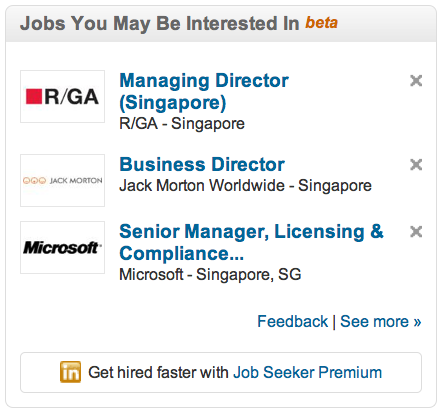LinkedIn – A Recruitment Revolution?
I got the following mail from LinkedIn earlier today:
It’s short and to the point: lots of my network made a professional move in 2011, and many of them chose to share the news on LinkedIn.
While the message obviously has personal interest – I connect with people on LinkedIn because I want to know more about their professional activities – it struck me that this mail was part of something bigger.
LinkedIn is already widely regarded as an effective platform for professional networking, but the site appears to be gearing itself up to become a one-stop shop for social recruitment too.
This isn’t exactly a well kept secret, as the following feature demonstrates:
However, it’s clear that LinkedIn is now pushing this aspect of its service a lot harder.
A few months ago, the following ads started popping up on the site:
Around about the same time, the following section started appearing on my LinkedIn homepage:
These quickly piqued my attention – from a purely social media perspective of course (don’t tell Nathan or Robin that I clicked on the links, hey?).
If you click on the ‘See more’ link in one of these ads, it takes you to a page where LinkedIn’s networking element really comes in to play:
From a company’s perspective, it’s clear why this sort of job posting makes sense – as a recruiter, getting ‘qualified referrals’ via your own network makes the task of looking for quality hires a lot simpler.
Moreover, the price of a job posting on LinkedIn is fairly competitive when compared to the equivalent cost in traditional, industry print media.
However, click on the ‘Job Seeker Premium’ link at the bottom of one of those ads, and things start to get really interesting:
Rather than simply getting recruiters to pay to use the site, it seems LinkedIn believe they can persuade jobseekers to pay for premium services too – and as you can see from the screenshot below, the ‘premium’ service comes with a premium price:
Of course, the S$720 (~US$565) annual fee would be easy to justify in cases where it helps to secure a great move, but it’s the sheer revenue potential that this service presents that’s so intriguing.
Supposing that just one in every thousand of LinkedIn’s current user base opted for the most basic plan outlined above, the site would generate more than US$ 2.5 million from this service alone – not a bad prospect for a company that has raised a few eyebrows amongst the investment world recently.
It actually seems quite promising.
This is just one of the areas we expect LinkedIn to push this year, though.
With the increasing importance of Enterprise Social, we wouldn’t be surprised to see internal networking becoming more of a focus for the platform in the coming months too.
Watch this space…






